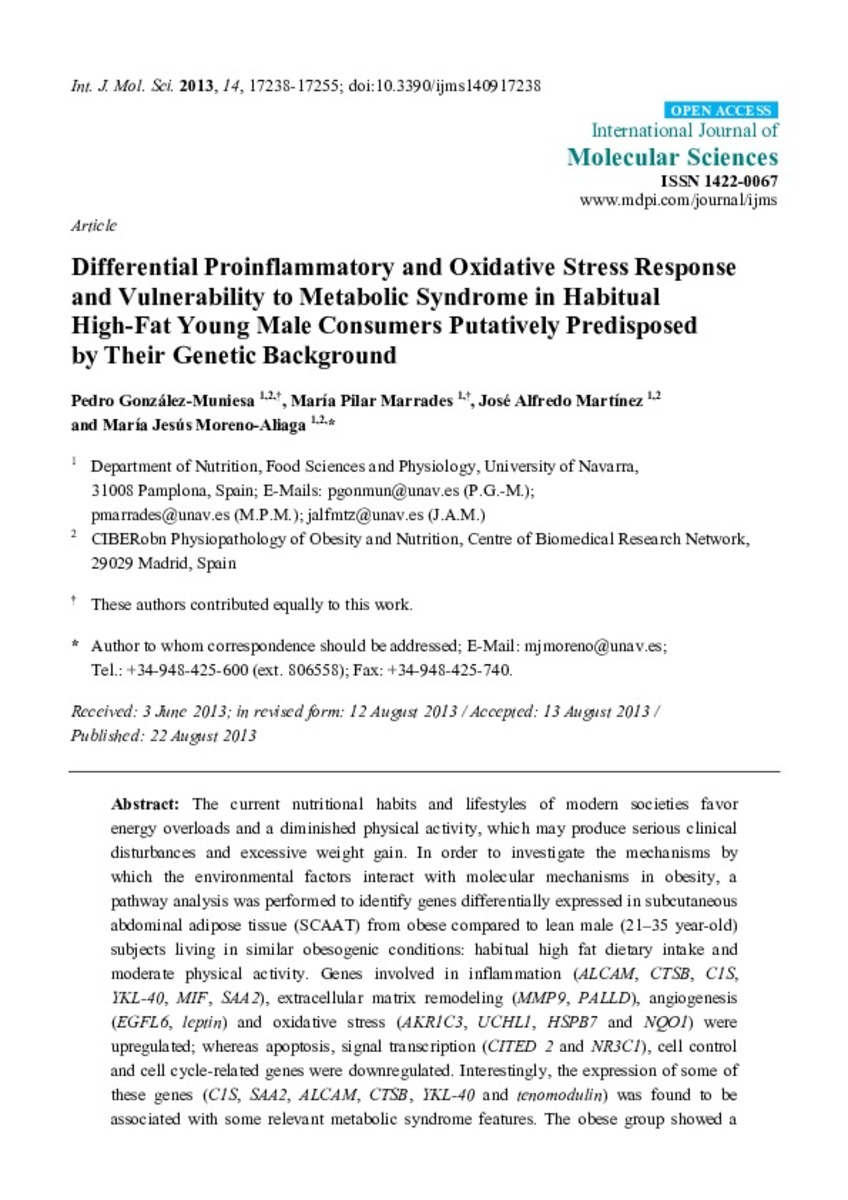Full metadata record
| DC Field | Value | Language |
|---|---|---|
| dc.creator | Gonzalez-Muniesa, P. (Pedro) | - |
| dc.creator | Marrades, M.P. (María Pilar) | - |
| dc.creator | Martinez, J.A. (José Alfredo) | - |
| dc.creator | Moreno-Aliaga, M. J. (María Jesús) | - |
| dc.date.accessioned | 2013-09-16T17:04:42Z | - |
| dc.date.available | 2013-09-16T17:04:42Z | - |
| dc.date.issued | 2013 | - |
| dc.identifier.citation | Gonzalez-Muniesa P, Marrades MP, Martinez JA, Moreno-Aliaga MJ. Differential proinflammatory and oxidative stress response and vulnerability to metabolic syndrome in habitual high-fat young male consumers putatively predisposed by their genetic background. International journal of molecular sciences 2013 2013;14(9):17238-17255 | es_ES |
| dc.identifier.issn | 1661-6596 | - |
| dc.identifier.uri | https://hdl.handle.net/10171/29673 | - |
| dc.description.abstract | The current nutritional habits and lifestyles of modern societies favor energy overloads and a diminished physical activity, which may produce serious clinical disturbances and excessive weight gain. In order to investigate the mechanisms by which the environmental factors interact with molecular mechanisms in obesity, a pathway analysis was performed to identify genes differentially expressed in subcutaneous abdominal adipose tissue (SCAAT) from obese compared to lean male (21-35 year-old) subjects living in similar obesogenic conditions: habitual high fat dietary intake and moderate physical activity. Genes involved in inflammation (ALCAM, CTSB, C1S, YKL-40, MIF, SAA2), extracellular matrix remodeling (MMP9, PALLD), angiogenesis (EGFL6, leptin) and oxidative stress (AKR1C3, UCHL1, HSPB7 and NQO1) were upregulated; whereas apoptosis, signal transcription (CITED 2 and NR3C1), cell control and cell cycle-related genes were downregulated. Interestingly, the expression of some of these genes (C1S, SAA2, ALCAM, CTSB, YKL-40 and tenomodulin) was found to be associated with some relevant metabolic syndrome features. The obese group showed a general upregulation in the expression of inflammatory, oxidative stress, extracellular remodeling and angiogenic genes compared to lean subjects, suggesting that a given genetic background in an obesogenic environment could underlie the resistance to gaining weight and obesity-associated manifestations. | es_ES |
| dc.language.iso | eng | es_ES |
| dc.publisher | MDPI | es_ES |
| dc.rights | info:eu-repo/semantics/openAccess | es_ES |
| dc.subject | Metabolic syndrome | es_ES |
| dc.subject | Microarray | es_ES |
| dc.subject | Inflammation | es_ES |
| dc.subject | Oxidative stress | es_ES |
| dc.subject | Subcutaneous adipose tissue | es_ES |
| dc.title | Differential proinflammatory and oxidative stress response and vulnerability to metabolic syndrome in habitual high-fat young male consumers putatively predisposed by their genetic background | es_ES |
| dc.type | info:eu-repo/semantics/article | es_ES |
| dc.type.driver | info:eu-repo/semantics/article | es_ES |
| dc.identifier.doi | http://dx.doi.org/10.3390/ijms140917238 | es_ES |
Files in This Item:
Statistics and impact
Items in Dadun are protected by copyright, with all rights reserved, unless otherwise indicated.






